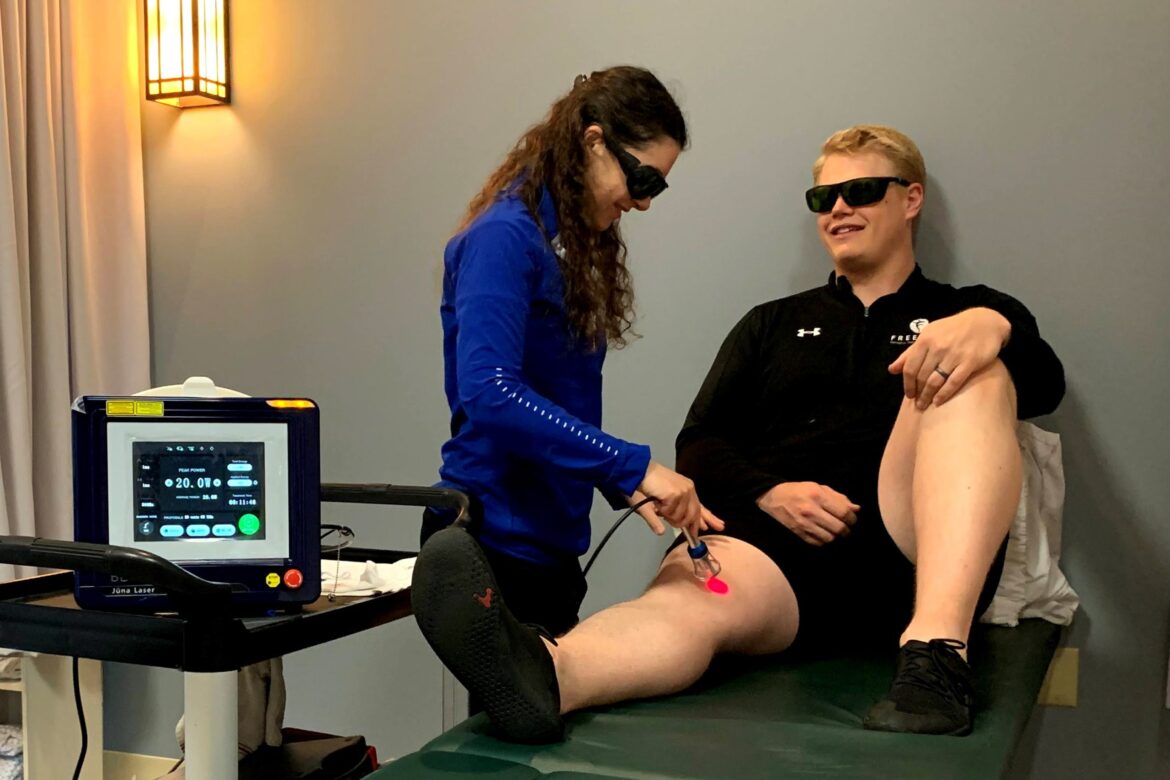Freedom Therapeutic Laser Therapy
LASER stands for Light Amplification by Stimulated Emission of Radiation. The New Freedom Laser, available at all locations, is another great adjunct to the treatment that Freedom already offers.
Therapy lasers have been used and researched extensively in Europe for more than 30 years. However, the United States Food and Drug Administration (FDA) only cleared a low-level laser in 2002, and the first-class IV therapy laser in 2003( Freedom Berman Lasers are Class IV at 980 NM wavelength. Low-Level Laser Therapy (LLLT) and its known effects have already been reviewed extensively in many journals. The most important clinical and therapeutic difference between Class IV laser therapy- Freedom’s Lasers and LLLT is that the Class IV can produce a primary bio-stimulation effect on deeper tissues than lower-powered lasers— while also producing substantial secondary and tertiary effects. The FDA approved indications for use of Class IV laser include the following:
- Relief of muscle and joint aches, pain, and stiffness
- Relaxation of muscles and muscle spasms
- Temporary increase in local blood circulation
- Relief of pain and stiffness associated with arthritis
These four barely scratch the surface, there are papers showing benefits on foot neuropathy, Raynaud’s, post-herpetic neuralgia, toe fungus, lymphedema, the list goes on. This is not a cure-all, but neither are most treatments, right? LASER is a powerful tool and adjunct to facilitate all the other skills and techniques the Freedom PT therapists currently use.
The difference in Lasers
In general, Class IIIa lasers have a power output of 1 to 5 milliwatts (1-5mW), Class IIIB lasers output power up to 500 mW, or 0.5 watts, and Class IV lasers include all of those with power output higher than 0.5 watts (500 mW). Laser therapy dosing is measured in joules/cm2. One watt is equal to 1 joule/second. So, if a therapy laser has 15 W of power, and the treatment is 1 minute long, that’s a total of 900 J delivered.
One of the amazing benefits of our Class 4 high-powered laser is we can treat a larger area, more effectively, more efficiently, in less time.
So for example our little hand-held laser is only 50mw, if you set our new class IV laser at only 1 watt, it is already 20 times more powerful!! And of course, that little laser I believe, is about 640NM wavelength so at the very low end of therapeutic benefit. We know the little laser has its perks – it works well on very superficial trigger points, etc. But as a point of reference, so you understand the value of our lasers, say we are treating the rotator cuff, and we want to administer 4000 joules/cm2 with our laser at only 10 watts, so that would be 10 joules a second, or 600 joules a min or a treatment time of about 6.6 min, vs our 50mW laser it would take 1,333 minutes or 22 hours to treat the same area.
As another example: When treating with a class IV diode laser, the currently accepted dosage for deep-lying pain is 4-10 J/cm. Simple calculations show that if the condition being treated is lumbar pain, the area being treated could be 100 to 400 cm2—or even larger if it is accompanied by radiculopathy. This equates to a total treatment dosage of 400 to 4000 joules. If the treatment device was a 500 mW laser (so a laser 10 times more powerful than our little silver handheld one), it would take anywhere from 13 to 133 minutes to administer this dosage. However, a Class IV therapy laser could accomplish this task in less than 10 minutes.
The Freedom Laser is different than others
Like everything we do every day at Freedom it can take 3 to 4 sessions no matter what we do, to find the right therapeutic balance that is right for each of our unique patients.
Laser light becomes less effective the further from the surface it penetrates. The MLS lasers treat off the skin, and as a result, they get what is called scatter which affects the value and depth of penetration. The beneficial effects are lost or reduced until it reaches a point at which the laser photon density is so low that no biological effect of the light can be measured.
We have utilized dry needling in the clinics for quite a few years now. The benefits and science of dry needling are similar to LASER. To me, this is just one more tool to use with our clients who can’t tolerate dry needling or as an additional benefit to dry needling. I look at the laser as being our form of trigger point injections, where we can blanket the surrounding areas and other trigger points we might not hit with our needle, to get an even higher bump in therapeutic pain relief, inflammation reduction, and acceleration healing in damaged tissues.
During a Class IV laser treatment, the treatment wand is kept in motion during the continuous wave phase and is pressed into the tissues for several seconds during laser pulsation. Patients feel a mild warmth and relaxation. Since tissue warming occurs from the outside-in, Class IV therapy lasers are safe to use over metal implants. After treatment, a clear majority of patients feel some change in their condition: be it pain reduction, improved range of motion, or some other benefit.
Therapy lasers have been an exciting addition to the health care treatment arsenal. The development of Class IV therapy lasers represents the next generation of light therapy. By maximizing the primary effects, Class IV therapy lasers can induce extremely rapid clinical responses. Progressive health care providers wanting to offer the latest technology to their clientele should investigate Class IV therapy lasers.
Learn more about the Freedom Laser or schedule your appointment with one today.

